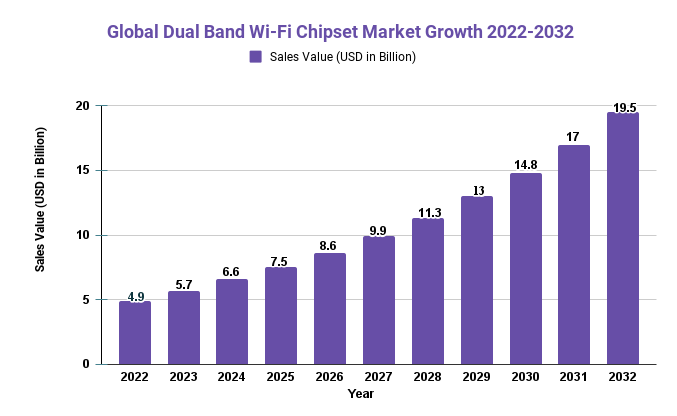Dual Band Wi-Fi Chipset Market Size Worth USD 19.5 Bn by 2032

Page Contents
Market Overview
The Dual Band Wi-Fi Chipset Market refers to Wi-Fi chipsets that operate on two frequency bands – 2.4 GHz and 5 GHz. These are widely used in devices like routers, smartphones, tablets, laptops, and other Internet of Things (IoT) devices.
In 2022, the Dual Band Wi-Fi Chipset Market was valued at USD 4.9 Bn. By 2032, analysts predict it will reach around USD 19.5 Bn with a compound annual growth rate (CAGR) of 14.6% from 2022-2032.
The growth of this market is being spurred on by an increasing need for high-speed internet connection and the growing adoption of IoT devices.
Asia-Pacific is the leading region for dual-band Wi-Fi chipsets, with countries such as China, Japan, and India driving the market growth. This region boasts an abundance of smartphone and IoT device users which has contributed to the demand for these types of chipsets. Furthermore, increasing internet penetration rates and rising disposable incomes among consumers are further fueling market expansion in this area.
North America and Europe are major markets for dual-band Wi-Fi chipsets, with the United States and Western European countries contributing the most growth to these regions. The increasing adoption of advanced technologies such as 5G, IoT, and artificial intelligence (AI) is fueling demand for high-speed internet connection – in turn stimulating growth in the dual-band Wi-Fi chipset market.

Drivers, trends, and challenges have an impact on market dynamics, which can impact businesses. Request for PDF sample report
Demand Analysis
The demand for dual-band Wi-Fi chipsets are being driven primarily by the rising adoption of high-speed internet connectivity and an escalating number of IoT devices. With 5G and AI technologies gaining traction, there's been an increased need for faster and more dependable internet connections – leading to an uptick in dual-band Wi-Fi chipset sales. Furthermore, smart homes and wearables have further added to this demand for these chipsets.
Top Key Trends
One of the major drivers in the dual-band Wi-Fi chipset market is the increasing adoption of 802.11ax (Wi-Fi 6) technology. This new standard offers improved speed and efficiency over 802.11ac (Wi-Fi 5), making it a preferred option for high-speed internet connection. Furthermore, demand for Wi-Fi chipsets from automotive OEMs has grown as connected cars become more common and require fast internet access.
Top Impacting Factors
One of the key drivers for growth in the dual-band Wi-Fi chipset market is the increasing adoption of IoT devices such as smart homes and wearables. With increased internet penetration rates and rising disposable incomes among consumers, there is a rising need for fast and dependable internet connections; this has fuelled demand for dual-band Wi-Fi chipsets. Furthermore, connected cars require high-speed internet connection, further fueling demand in this space.
Key Benefits for Stakeholders
Companies in the dual-band Wi-Fi chipset market can gain from an increasing need for high-speed internet connection and the rising adoption of IoT devices. With 5G and AI technologies coming online, there is an increasing need for faster, more dependable internet connections – driving demand for dual-band Wi-Fi chipsets. Furthermore, with smart homes and wearables becoming more commonplace, this growth presents stakeholders with an opportunity to capitalize on this rapidly developing market and expand their business operations accordingly.
Drivers
The dual-band Wi-Fi chipset market is being driven by several factors. One key driver is the rising adoption of high-speed internet due to 5G and AI technologies, driving demand for dual-band Wi-Fi chipsets. Furthermore, IoT devices such as smart homes and wearables require fast internet connections; further fuelling demand in this space. Moreover, rising internet penetration levels and rising disposable incomes among consumers are further fueling market expansion.
Restraints
Despite the growth drivers, there are also some challenges facing the dual-band Wi-Fi chipset market. One major barrier is the presence of alternative technologies like cellular data networks or Bluetooth which offer similar functions as Wi-Fi; thus, this could limit growth in this space. Moreover, costs for dual-band Wi-Fi chipsets may prove prohibitive in certain markets due to security and privacy worries.
Opportunities
The dual-band Wi-Fi chipset market presents several growth prospects. One key opportunity lies in the growing demand for Wi-Fi chipsets in the automotive industry, as connected cars become more common and require high-speed internet connection. Furthermore, Wi-Fi 6 technology offers improved speed and efficiency compared to previous technologies; furthermore, an increasing number of IoT devices and increased internet speed provide additional growth prospects for this market.
Challenges
One of the primary obstacles faced by the dual-band Wi-Fi chipset industry is competition from alternative technologies like cellular data networks or Bluetooth, which offer similar functionalities as Wi-Fi. This could restrict the market growth. Furthermore, costs associated with dual-band Wi-Fi chipsets may prove prohibitive in certain regions. Furthermore, security and privacy concerns pose another hurdle to overcome for this sector.
Recent Developments
Recently, there has been an emphasis on creating more efficient and high-performance Wi-Fi chipsets. For instance, some companies are working on designing chips with improved power efficiency and longer battery life. Furthermore, companies are striving to develop chipsets capable of supporting Wi-Fi 6 technology which offers improved speed and efficiency compared to previous technologies.
Key Market Segments
Type
- 11ay
- 11ax
- 11ac Wave 2
- Others
Application
- Smartphones
- Tablet
- PCs
- Access Point Equipment
- Connected Home Devices
- Others
Key Market Players
- Qualcomm TechnologiesInc.
- MediaTek Inc.
- Intel Corporation
- Texas Instruments Incorporated.
- STMicroelectronics N.V. Cypress Semiconductor Corporation
- Marvell Technology Group Ltd. (Bermuda)
- Samsung Electronics Co.Ltd. Quantenna Communications Inc.
- Peraso TechnologiesInc.
Report Scope
| Report Attribute | Details |
| The market size value in 2022 | USD 1.3 Bn |
| Revenue forecast by 2032 | USD 2.6 Bn |
| Growth Rate | CAGR Of 7.5% |
| Regions Covered | North America, Europe, Asia Pacific, Latin America, and Middle East & Africa, and Rest of the World |
| Historical Years | 2017-2022 |
| Base Year | 2022 |
| Estimated Year | 2023 |
| Short-Term Projection Year | 2028 |
| Long-Term Projected Year | 2032 |
Frequently Asked Questions
Q: What is a dual-band Wi-Fi chipset?
A: A dual-band Wi-Fi chipset is a type of Wi-Fi chipset that operates on two frequency bands – 2.4 GHz and 5 GHz. These chipsets are widely used in devices such as routers, smartphones, tablets, laptops, and other Internet of Things (IoT) devices.
Q: What is driving the growth of the dual-band Wi-Fi chipset market?
A: The growth of the dual-band Wi-Fi chipset industry is driven by the increasing demand for high-speed internet connectivity and the growing adoption of IoT devices. With the rise of 5G and AI, there is a growing need for faster and more reliable internet connectivity, which is driving the demand for dual-band Wi-Fi chipsets.
Q: What are the key trends in the dual-band Wi-Fi chipset market?
A: One of the key trends in the dual-band Wi-Fi chipset market is the increasing adoption of 802.11ax (Wi-Fi 6) technology. Another trend is the growing demand for Wi-Fi chipsets in the automotive industry, as connected cars become more common and require high-speed internet connectivity.
Q: What are the key challenges for the dual-band Wi-Fi chipset market?
A: The key challenges for the dual-band Wi-Fi chipset market include the availability of alternative technologies, such as cellular data networks and Bluetooth, the high cost of dual-band Wi-Fi chipsets, and concerns around security and privacy.
The team behind market.us, marketresearch.biz, market.biz and more. Our purpose is to keep our customers ahead of the game with regard to the markets. They may fluctuate up or down, but we will help you to stay ahead of the curve in these market fluctuations. Our consistent growth and ability to deliver in-depth analyses and market insight has engaged genuine market players. They have faith in us to offer the data and information they require to make balanced and decisive marketing decisions.



